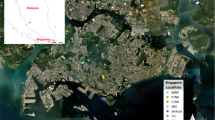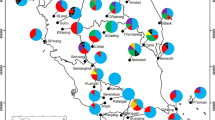Abstract
Colchicum autumnale L. (Colchicaceae) is classed as an endangered plant species in Ireland, with a highly localised distribution centred on the Nore Valley in the southeast. The high resolution Amplified Fragment Length Polymorphism genetic fingerprinting technique was used to clarify a question over the native status of the species and to assess its Irish conservation status through comparison with populations throughout northwestern Europe. The analysis of 20 populations with three selective primer pairs yielded 155 markers, 90% of which displayed polymorphism. Allele frequency was estimated using a Bayesian approach and based on this, total gene diversity (Ht) was 0.305 and mean within-population gene diversity (Hw) was 0.142. Irish populations contain comparatively moderate levels of genetic diversity and are unlikely to be susceptible to the deleterious effects of inbreeding depression. Analysis of Molecular Variance revealed that populations were significantly differentiated, with 68% of variation partitioned among populations and 32% within. Neighbour-joining and ordination analyses revealed a major biogeographic division between populations, suggesting that post-glacial migration in northwest Europe was driven from at least two separate glacial refugia and that the re-colonisation of Britain and Ireland is likely to have occurred via a western seaboard route from an Iberian glacial refugium. The total evidence points to C. autumnale being a native component of the Irish flora and its endangered IUCN (World Conservation Union) country status should therefore make it a priority for national conservation efforts. The study illustrates the point that a broader geographical perspective is fundamental to the assessment of the conservation status of regionally threatened plant species.



Similar content being viewed by others
References
Ainsworth CC, Parker JS, Horton DM (1983) Chromosome variation and evolution in Scilla autumnalis. Kew Chromosome Conference II. HMSO London
Angiosperm Phylogeny Group (2003) An update of the angiosperm phylogeny group classification for the orders and families of flowering plants: APG II. Bot J Linn Soc 141:399–436
Bateman R, Smith RJ, Fay MF (2008) Origin, evolutionary significance and conservation implications of Orchis × angusticruris (O. purpurea × O. simia), a hybrid orchid new to the British Isles. Biol J Linn Soc 157:687–711
Bonin A, Bellemain E, Bronken Eidesen P, Pompanon F, Brochmann C, Taberlet P (2004) How to track and assess genotyping errors in population genetics studies. Mol Ecol 13:3261–3273
Butcher RW (1954) Biological flora of the British Isles. Colchicum autumnale L. J Ecol 42:249–257
Casgrain P (1999). Le Progiciel Rv4.0d1. Development Release
Chase MW, Hills HG (1991) Silica gel: an ideal material for field preservation of leaf samples for DNA studies. Taxon 40:215–220
Cottrell JE, Munro RC, Tabbener HE, Gillies ACM, Forrest GI, Deans JD, Lowe AJ (2002) Distribution of chloroplast DNA variation in British oaks (Quercus robur and Q. petraea): the influence of postglacial colonisation and human management. For Ecol Manag 156:181–195
Cox CB, Moore PD (2000) Biogeography. An ecological and evolutionary approach. Blackwell, Oxford
Curtis TGF, McGough HN (1988) The Irish red data book. 1 vascular plants. Wildlife Service, Office of Public Works, Dublin
Dice LR (1945) Measures of the amount of ecological association between species. Ecology 26:297–307
Doyle JJ, Doyle JL (1988) Isolation of plant DNA from fresh tissue. Focus 12:13–15
Dumolin-Lapègue S, Demesure B, Fineschi S, Corre VL, Petit RJ (1997) Phylogeographic structure of white oaks throughout the European continent. Genetics 146:1475–1487
Griggs RF (1914) Observations on the behaviour of some species at the edges of their ranges. B Torrey Bot Club 41:25–49
Grivet D, Petit RJ (2002) Phylogeography of the common ivy (Hedera sp.) in Europe: genetic differentiation through space and time. Mol Ecol 11:1351–1362
Hamrick JL, Godt MJW (1996) Effects of life history traits on genetic diversity in plant species. Philos Trans R Soc Lond Ser B Biol Sci 351:1291–1298
Hartung EF (1954) History of the use of Colchicum and related medicaments in gout with suggestions for further research. Ann Rheum Dis 13:190–200
He T, Rao G, You R, Ge S, Zhang D (2000) Genetic diversity of widespread Ophiopogon intermedius (Liliaceae s.l.): a comparison with endangered O. xylorrhizus. Biol Conserv 96:253–257
Hengeveld R, Haeck J (1982) The distribution of abundance. I. Measurements, http://www.jstor.org/stable/2844717. J Biogeogr 9:303–316
Hewitt G (2000) The genetic legacy of the quaternary ice ages. Nature 405:907–913
James EA, Ashburner GR (1997) Intraspecific variation in Astelia australiana (Liliaceae) and implications for the conservation of this Australian species. Biol Conserv 82:253–261
Kang M, Jiang M, Huang H (2005) Genetic diversity in fragmented populations of Berchemiella wilsonii var. pubipetiolata (Rhamnaceae). Ann Bot 95:1145–1151
Kelleher CT, Hodkinson TR, Kelly DL, Douglas GC (2004) Characterisation of chloroplast DNA haplotypes to reveal the provenance and genetic structure of oaks in Ireland. For Ecol Manag 189:123–131
Kim ST, Chung MG (1995) Genetic and clonal structure in Korean populations of Calystegia japonica (Convolvulaceae). Bot Bull Acad Sin 36:135–141
Kingston N, Waldren S (2006) Biogeography of the Irish ‘Lusitanian’ heathers. In: Leach SJ, Page CN, Peytoureau Y, Sanford MN (eds) Botanical links in the Atlantic arc. Botanical Society of the British Isles, London, pp 147–156
Koch M, Bernhardt K (2004) Comparative biogeography of the cytotypes of annual Microthlaspi perfoliatum (Brassicaeae) in Europe using isozymes and cpDNA data: refugia, diversity centers, and postglacial colonisation. Am J Bot 91:115–124
Lumaret R, Mir C, Michaud H, Raynal V (2002) Phylogeographical variation of chloroplast DNA in holm oak (Quercus ilex L.). Mol Ecol 11:2327–2336
Lynch M, Milligan B (1994) Analysis of population genetic structure with RAPD markers. Mol Ecol 3:91–99
Nei M (1973) Analysis of gene diversity in sub-divided populations. Proc Natl Acad Sci USA 70:3321–3323
Newton AC, Allnutt TR, Gillies ACM, Lowe AJ, Ennos RA (1999) Molecular phylogeography, intraspecific variation and the conservation of tree species. Trends Ecol Evol 14:140–145
Pappert RA, Hamrick JL, Donovan LA (2000) Genetic variation in Pueraria lobata (Fabaceae), an introduced, clonal, invasive plant of the southeastern United States. Am J Bot 87:1240–1245
Persson HA, Lundquist K, Nybom H (1998) RAPD analysis of genetic variation within and among populations of Turk’s-cap lily (Lilium martagon, L.) Hereditas 128:213–220
Petit RJ, Brewer S, Bordács S et al (2002) Identification of refugia and post-glacial colonisation routes of European white oaks based on chloroplast DNA and fossil pollen evidence. For Ecol Manag 156:49–74
Rendell S, Ennos RA (2003) Chloroplast DNA diversity of the dioecious European tree Ilex aquifolium L. (English holly). Mol Ecol 12:2681–2688
Schneider S, Roessli D, Excoffier L (2000) Arlequin ver 2.000: a software for population genetic data analysis. Genetics and Biometry Laboratory, University of Geneva, Switzerland
Skrede I, Eidesen PB, Portela RP, Brochmann C (2006) Refugia, differentiation and postglacial migration in arctic-alpine Eurasia, exemplified by the mountain avens (Dryas octopetala L.). Mol Ecol 15:1827–1840
Smith RJ (2004) Conservation biology of Colchicum autumnale L. and Campanula trachelium L. in the Nore Valley, Southeast Ireland. PhD Thesis, Trinity College, Dublin
Smith RJ, Waldren S (2006) Genetic variation in Irish threatened plant species: a European perspective. In: Leach SJ, Page CN, Peytoureau Y, Sanford MN (eds) Botanical links in the Atlantic arc. Botanical Society of the British Isles, London, pp 137–145
Swofford DL (2001) PAUP* 4.0: phylogenetic analysis using parsimony (*and other methods). Sinauer Associates, Sunderland, Massachusetts
Taberlet P, Fumagalli L, Wust-Saucy A, Cosson J (1998) Comparative phylogeography and postglacial colonisation routes in Europe. Mol Ecol 7:453–464
Van Der Merwe M, Winfield MO, Arnold GM, Parker JS (2000) Spatial and temporal aspects of the genetic structure of Juniperus communis populations. Mol Ecol 9:379–386
Vekemans X (2002) AFLP-SURV version 1.0. Distributed by the author. Laboratoire de Génétique et Ecologie Végétale, Université Libre de Bruxelles, Belgique
Vos P, Hogers R, Bleeker M, Reijans M, van de Lee T, Hornes M, Frijters A, Pot J, Peleman J, Kuiper M, Zabeau M (1995) AFLP: a new technique for DNA fingerprinting. Nucleic Acid Res 23:4407–4414
Webb DA (1983) The flora of Ireland in its European context: the Boyle medal discourse 1982. J Life Sci R Dublin Soc 4:143–160
Zhivotovsky LA (1999) Estimating population structure in diploids with multilocus dominant DNA markers. Mol Ecol 8:907–913
Acknowledgments
This work formed part of a PhD funded by National Parks and Wildlife Service (NPWS, formerly Dúchas, the Heritage Service) and Trinity College Dublin (TCD). The European sampling of populations was made possible with a grant from the Botanical Society of the British Isles (BSBI). Thanks to Tom Curtis for field expertise and supervision, Trevor Hodkinson (TCD) for lab guidance, and to John Parker (University of Cambridge) for his valuable comments and insight as external examiner. Thanks also to Clive Jermy (BSBI), Rob Canning, Julie Smith, Hugh Smith, Sally McSweeney, Richard Nairn, Michael Tennyson, Joseph Teesdale, George Dyer, Kevin and Louise Barnes, Walter Walsh, Padraic Comerford (NPWS), Lorcan Scott (NPWS), Isabelle Diana (Jardin Botanique de l’Université et de la Ville, Besançon), José Daniel Gòmez Garcia (Instituto Pirenaico de Ecología), Max Debussche (Centre d’Ecologie Fonctionnelle et Evolutive/Centre National de la Recherche Scientifique), Romaric Pierrel (Conservatoire et Jardins Botanique de Nancy), Mikel Lorda, Pedro-Uribe Echebaria, Frederic Bioret (Université de Bretagne Occidentale), Julian Woodman (Countryside Council for Wales), Clive Falkner (Montgomeryshire Wildlife Trust), Gwent Wildlife Trust, David Northcote-Wright (Somerset Wildlife Trust), Hanson Aggregates and BSBI V.C. recorders: H. J. M. Bowen, Trevor Evans, Stephen Evans, Dave Green, Jean Green, Quentin Kay, Mark Kitchen, Clare Kitchen and Marjorie Wainwright.
Author information
Authors and Affiliations
Corresponding author
Rights and permissions
About this article
Cite this article
Smith, R.J., Waldren, S. Patterns of genetic variation in Colchicum autumnale L. and its conservation status in Ireland: a broader perspective on local plant conservation. Conserv Genet 11, 1351–1361 (2010). https://doi.org/10.1007/s10592-009-9964-3
Received:
Accepted:
Published:
Issue Date:
DOI: https://doi.org/10.1007/s10592-009-9964-3




